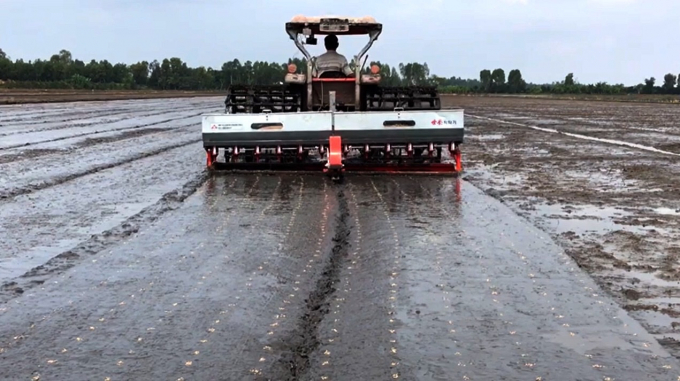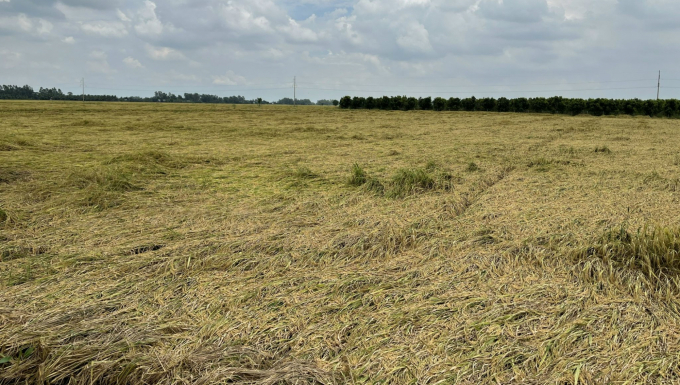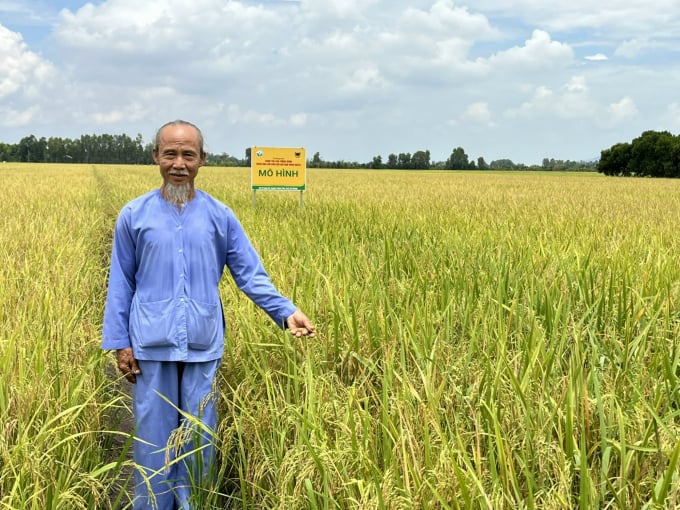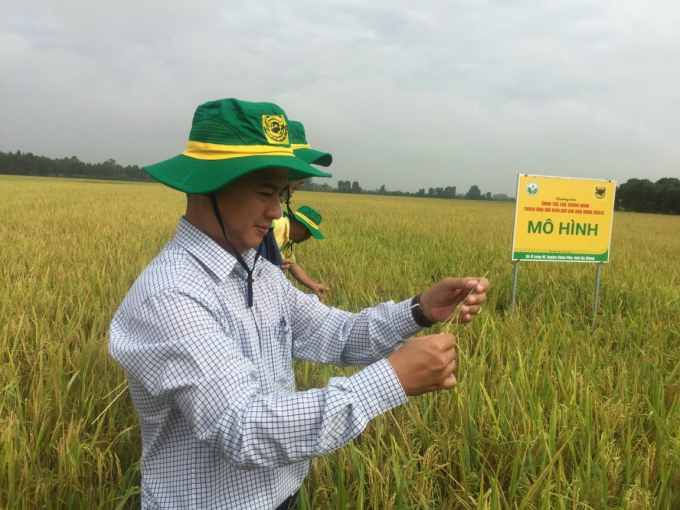May 25, 2025 | 21:51 GMT +7
May 25, 2025 | 21:51 GMT +7
Hotline: 0913.378.918
May 25, 2025 | 21:51 GMT +7
Hotline: 0913.378.918

Farmers visit a model of transplanting rice in clusters combined with other synchronous rice farming techniques in O Long Vi Commune, Chau Phu District, An Giang Province, on the morning of March 22, 2022.
The method of transplanting rice in clusters helps to reduce the amount of rice seeds, fertilizers and pesticides while increasing yield and economic efficiency of rice production in different intensive farming conditions using different fertilizers.
Particularly, this cluster transplanting method will create further advantages if combined with other synchronous technical solutions, like the use of Binh Dien specialized fertilizers.
In the winter-spring crop 2021-2022, An Giang Agricultural Extension Center simultaneously deployed a smart rice farming model to adapt to climate change in three localities – Tan An Commune; Tan Chau Town, Vinh Hanh Commune, Chau Thanh District and O Long Vi Commune, Chau Phu District.
The cluster rice transplanting model implemented in O Long Vi Commune, Chau Phu District has been successful in many localities in the Mekong Delta.

A rice transplanting machine at O Long Vi Commune, Chau Phu District, An Giang on December 22, 2021. The amount of seed sown is 60kg/ha.
The model was conducted by four local households, each of whom spends an area of 0.5 ha (in the model) applying Binh Dien specialized fertilizers (Alum salt buffalo head, TE A1 buffalo head and TE A2 buffalo head). The remaining area of the field (excluded from the model) is fertilized with other kinds sold in the local markets according to local practices.
Method of transplanting: One household transplants rice in clusters on the area both inside and outside the model (60 kg of seed/ha) and the remaining three households transplant in the regularly way (80 kg of seed/ha in the model area and 110 kg of seed/ha on the area outside the model).
The difference of the cluster transplanting method and the current popular one is that the seeds in the first one are transplanted in clusters with specialised machine imported from South Korea, which ensures that the distance between rows and clusters and the number of seeds in each cluster can be adjusted according to the requirements of the farming season, the growing time of the rice variety, the fertility of the land and the level of cultivation.
Another fundamental distinction of the cluster transplanting method is the minimum use of seeds, from 40 to 60 kg/ha compared with the commonly used method of 120 - 150 kg/ha, which means a reduction of 60 - 70% of seeds.
The results of the model implementation show that the cluster transplanting model produced a yield of 7.2 tons/ha, which is 0.7 tons/ha higher than that of the traditional model, which reaches only 6.5 tons/ha (increasing 11% in yield).
Thereby, the cluster transplanting model earned a profit of VND19.4 million/ha, VND2.4 million/ha higher than the profit of the existing model using fertilisers on the market that only reached VND17 million/ha (an increase of 14% in economic efficiency).

Rice that is traditionally transplanted falls down completely.


Rice transplanted in clusters by machine grows stronger and produces firm and bright seeds.
Secondly, the model using Binh Dien specialized fertilizer also gives a high yield, reaching 7.7 tons/ha, 1.0 tons/ha higher than that of the popular model that only reached 6.7 tons/ha (14.9% increase in yield).
The cluster transplanting model therefore gave high profits, reaching VND 23.4 million/ha, increased 24.5% in economic efficiency.
Moreover, the results show that the cluster transplanting model helps to reduce the amount of not only seeds but also fertilizers and pesticides. At the same time, it is proved to increase rice yield and increase economic efficiency of rice production in many different intensive conditions and with many different fertilizers.
They are expected to bring about further advantages if combined with other synchronous technical solutions, like the use of Binh Dien specialized fertilizers.
Video shows that rice that is traditionally transplanted falls down completely.
Video shows that rice transplated in clusters by machines has higher resistance.
Translated by Phuong Ha
/2025/05/25/4127-3-073637_820.jpg)
(VAN) Thanks to the promotion from an FAO-implemented project, vegetable production in greenhouses in Moc Chau has seen strong development, from 1.5 hectares in 2021 to nearly 50 hectares in 2024.

(VAN) FAO has recently supported USD 140,000 to implement the project 'Risk mitigation human-animal interface risks through disease control initiatives in pig farming.'

(VAN) The People's Committee of Tra Vinh province has approved an adjustment to the investment policy for the Green Hydrogen Plant project, increasing its area to approximately 52.76 hectares.
![Reducing emissions from rice fields: [2] Farmers’ commitment to the soil](https://t.ex-cdn.com/nongnghiepmoitruong.vn/608w/files/news/2025/05/05/dsc08881jpg-nongnghiep-140632.jpg)
(VAN) Clean rice cultivation model in Thuong Tan commune, Bac Tan Uyen district, is assisting local residents in achieving sustainable agriculture by substantially reducing costs, increasing productivity, and protecting the environment.

(VAN) At the conference to disseminate Resolution No. 68, AgriS introduced its digital agricultural ecosystem and reaffirmed its commitment to accompanying the Government in promoting private sector development and sustainable agriculture.

(VAN) 'Blue Ocean - Blue Foods' initiative is designed to restore marine ecosystems and establish sustainable livelihoods for local communities by cultivating a minimum of 1,000 hectares of cottonii seaweed in the first three years.
/2025/05/21/4642-3-112707_603.jpg)
(VAN) The V-SCOPE project has made direct contributions to three out of six pillars of the Comprehensive Strategic Partnership between Vietnam and Australia.